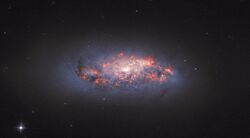Astronomy:NGC 972
| NGC 972 | |
|---|---|
 NGC 972 taken by Hubble Space Telescope.[1] | |
| Observation data (J2000[2] epoch) | |
| Constellation | Aries |
| Right ascension | 02h 34m 13.385s[3] |
| Declination | +29° 18′ 40.47″[3] |
| Redshift | 0.005147[2] |
| Helio radial velocity | 1,541 km/s[4] |
| Distance | 49.8 Mly (15.28 Mpc)[4] |
| Apparent magnitude (B) | 12.1[2] |
| Characteristics | |
| Type | Sb or Sd[5] |
| Mass | 1.2×1010 M☉[5] M☉ |
| Apparent size (V) | 10 arcmin[6] |
| Other designations | |
| LEDA 9788, MCG+05-07-010, UGC 2045[2] | |
NGC 972 is a dusty[5] spiral galaxy in the northern constellation of Aries, located at an approximate distance of 49.8 Mly[4] from the Milky Way. It was discovered in 1784 by William Herschel. The galactic features suggest it may have undergone a merger with a gas-rich companion, giving it asymmetrical arms, plus starburst activity in the nucleus and an off-planar nuclear ring. The inner 3.6 kpc of the galaxy is undergoing star formation at the rate of 2.1–2.7 M☉·yr−1,[7] but it lacks a nuclear bulge.[5]
On October 16, 2008, a possible supernova event was observed about 16.2″ west and 19.5″ north of the Galactic Center. It reached magnitude 14.7 in the infrared K' band, but only a possible very faint transient event was observed in the visual frequency range, most likely as a result of strong extinction.[8]
The group of galaxies around NGC 972 is sometimes referred to as the "NGC 972 group," which includes NGC 1012, NGC 1056, UGC 1958, UGC 2017, UGC 2053, and UGC 2221.[9][10]
References
- ↑ "In Bloom" (in en). https://spacetelescope.org/images/potw1926a/.
- ↑ 2.0 2.1 2.2 2.3 "NGC 972". SIMBAD. Centre de données astronomiques de Strasbourg. http://simbad.u-strasbg.fr/simbad/sim-basic?Ident=NGC+972.
- ↑ 3.0 3.1 Skrutskie, Michael F.; Cutri, Roc M.; Stiening, Rae; Weinberg, Martin D.; Schneider, Stephen E.; Carpenter, John M.; Beichman, Charles A.; Capps, Richard W. et al. (1 February 2006). "The Two Micron All Sky Survey (2MASS)". The Astronomical Journal 131 (2): 1163–1183. doi:10.1086/498708. ISSN 0004-6256. Bibcode: 2006AJ....131.1163S.
- ↑ 4.0 4.1 4.2 Tully, R. Brent et al. (2016). "Cosmicflows-3". The Astronomical Journal 152 (2): 21. doi:10.3847/0004-6256/152/2/50. 50. Bibcode: 2016AJ....152...50T.
- ↑ 5.0 5.1 5.2 5.3 Mayya, Y. D. et al. (October 1998). "Near-Infrared and Optical Morphology of the Dusty Galaxy NGC 972". The Astronomical Journal 116 (4): 1671–1678. doi:10.1086/300574. Bibcode: 1998AJ....116.1671M.
- ↑ "The galaxy NGC 972". https://in-the-sky.org/data/object.php?id=NGC972.
- ↑ Ravindranath, Swara; Prabhu, Tushar P. (June 1998). "Massive Star Formation in the Infrared-bright Galaxy NGC 972". The Astronomical Journal 115 (6): 2320–2330. doi:10.1086/300355. Bibcode: 1998AJ....115.2320R.
- ↑ Dudley, C. C. et al. (October 2008). Green, D. W. E.. ed. "Possible Reddened Supernovae in NGC 972 and NGC 5900". IAU Circular 8992: 1. Bibcode: 2008IAUC.8992....1D.
- ↑ Vennik, J.; Richter, G. M. (1994). "Surface Photometry of Low-Surface-Brightness Galaxies in the Area of the NGC 972 Group of Galaxies" (in en). Symposium - International Astronomical Union 161: 553–555. doi:10.1017/S0074180900048075. ISSN 0074-1809.
- ↑ Vennik, J.; Richter, G. M. (1994). "Photometry of groups of galaxies. II. The NGC 972 group" (in en). Astronomische Nachrichten 315 (3): 245–251. doi:10.1002/asna.2103150306. ISSN 1521-3994. Bibcode: 1994AN....315..245V. https://onlinelibrary.wiley.com/doi/abs/10.1002/asna.2103150306.
External links
Coordinates: ![]() 02h 34m 13.385s, +29° 18′ 40.47″
02h 34m 13.385s, +29° 18′ 40.47″
 |

